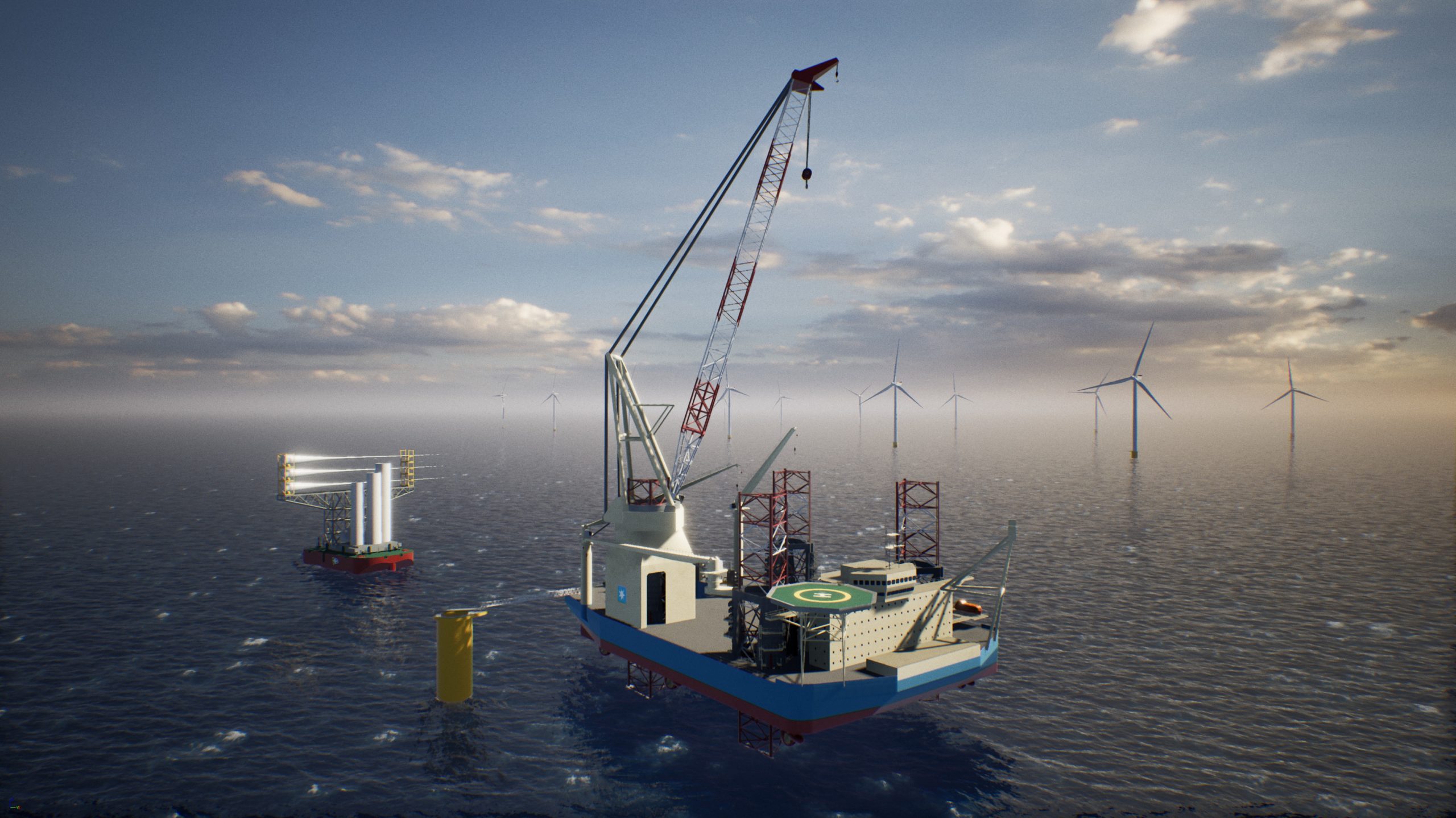Gunvor to Ship North Sea Crude to Asia After Bull Play Wraps Up
(Bloomberg) — Gunvor Group will send a supertanker loaded with North Sea Forties crude to Asia after the trading house amassed a large volume of benchmark oil in a month-long...


An illustration of a Sembcorp Marine-designed Wind Turbine Installation Vessel for Maersk Supply Service. Illustration courtesy Maersk Supply Service
Maersk Supply Service has been awarded a firm contract for the installation of offshore wind turbines at Equinor and BP’s Empire 1 and 2 offshore wind farms off New York State. The WTIV will be supported by two new Jones Act compliant tugs and feeder barges owned and operated by Kirby Corporation.
The contract will also result in Maersk Supply Service’s construction of its first Offshore Wind Installation Vessel, which the company has been designing since 2019. It will be the first dedicated offshore wind vessel in the Maersk fleet.
For the transport of components, Maersk Supply Service has partnered with Kirby Offshore Wind, a subsidiary of Kirby Corporation, one of the U.S.’s largest operators of offshore barges and towing vessels, who will provide two newbuild tugs and feeder barges that will be Jones Act-compliant.
The contract was awarded by Empire Offshore Wind, a joint venture between Equinor and BP which is developing
“In signing this contract with Equinor and bp, we are ready to invest in Maersk Supply Service’s first Wind Installation Vessel and firmly establish Maersk Supply Service as an offshore wind contractor,” says Steen S. Karstensen, CEO of Maersk Supply Service. Offshore wind continues to play an increasingly important role for Maersk Supply Service – both floating wind and bottom-fixed. With our legacy of complex project management and operations in harsh waters, Maersk Supply Service’s background and capabilities are well-matched to the offshore wind industry,”
The Wind Installation Vessel will be built by SembCorp Marine in Singapore, with steel-cutting set for Q4 2022 and delivery in U.S. expected in late 2025.
The Jones Act-compliant tugs and barges will be owned and operated by Kirby Offshore Wind and used transport the wind towers and turbines of up to 15 megawatts (MW) or more from the South Brooklyn Marine Terminal to Maersk’s wind turbine installation vessel stationed offshore.
Kirby says the new feeder barges and diesel-electric hybrid tugs will come with total combined cost of between $80 million to $100 million.
Maersk Supply Services says that by using feeder barges, the operation will be 30% more efficient than using conventional jack-up vessels. This method of installation—using Jones Act feeder vessels and a forgeign-flagged installation vessel—has also been identified one of the options for operators to maintain compliance with the Jones Act due to the lack of domestic WTIVs.
“Maersk’s wind turbine installation vessel is the first of its kind and will set a new standard for the efficiency of windfarm installations. The efficiency gains are made possible as the installation vessel can stay on location at the wind farm, while only the tugs and barges transport equipment to and from the port,” said Jonas Munch Agerskov, Chief Commercial Officer at Maersk Supply Service.
David Grzebinski, Kirby’s President and CEO, said he is excited about Kirby’s participation in the offshore wind market.
“We have been carefully evaluating opportunities to enter the offshore wind industry for several years, and we are very pleased to partner with world-class operators such as Maersk, Equinor, and bp on a critical foundational project with a multi-year transportation agreement,” said Grzebinski.
“Our commitment to build two next-generation feeder barges and emissions friendly diesel-electric hybrid tugboats, which could have the ability to substitute diesel for alternative fuels, is not only important for Kirby’s ESG journey, but also for the U.S. maritime sector. These vessels will create new American jobs, both during the construction phase at two U.S. shipyards, as well as for U.S. mariners once operations commence,” he added.
Christian O’Neil, Kirby’s President of Marine Transportation, also commented, “Offshore wind in the U.S. has tremendous potential for significant growth during this decade and beyond. As a leading provider of Jones Act compliant barge services in the U.S. coastal trade, Kirby’s participation in the development and support of the offshore wind industry is critical to our future.”
Both Maersk’s WTIV and Kirby’s tugs and barges will be classed by the American Bureau of Shipping (ABS).
Along with Equionor and BP’s Beacon Wind 1 project, the Empire Wind 1 and Empire Wind 2 projects will provide a total a 3.3 gigawatts of renewable power to the New York State, enough to produce electricity for about 2 million homes.
Equinor and BP in January finalized Purchase and Sale Agreements with New York State for the Beacon Wind 1 and Empire Wind 1 projects in January, marking one of the largest renewable energy procurements in United States history. The agreement includes transforming South Brooklyn Marine Terminal into a major staging and assembly facility for the offshore wind industry, as well as an operations and maintenance base for the offshore farms.
Kirby’s offshore wind activities will be based out of its marine facility in Staten Island, New York, as well as its marine headquarters in Houston, Texas.
Join the gCaptain Club for curated content, insider opinions, and vibrant community discussions.


Join the 107,104 members that receive our newsletter.
Have a news tip? Let us know.
Access exclusive insights, engage in vibrant discussions, and gain perspectives from our CEO.
Sign Up




Maritime and offshore news trusted by our 107,104 members delivered daily straight to your inbox.



Essential news coupled with the finest maritime content sourced from across the globe.
Sign Up